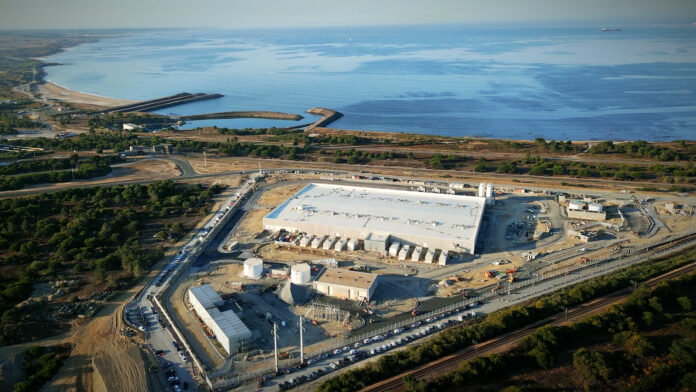Schneider Electric advances industrial AI with a factory-edge copilot in the US and a sustainable AI data center in Portugal, supporting regional ambitions for smart manufacturing and digital infrastructure.
In sum – what to know:
Factory AI copilots – Schneider launches generative AI assistants with Microsoft to tackle labour shortages and optimise factory performance.
Green AI hubs – It opens a 26MW renewable-powered data centre in Portugal to anchor Europe’s AI infrastructure and digital sovereignty.
Edge-to-core push – New hardware, robotics, and edge AI tools tighten Schneider’s grip from industrial shopfloor to sovereign cloud backbone.
Another industrial tech giant making new inroads with industrial-grade AI: following from Siemens’ claims about specialised agentic AI for Industry 5.0 earlier this week, France-based energy and automation specialist Schneider Electric has issued a couple of notices about new generative AI tooling at the factory edge and new AI infrastructure in municipal sovereign cloud heartlands – to run industrial AI workloads in the US and Europe, respectively, in support of their regional agendas around reindustrialisation and digital build-out. Both initiatives prioritize renewable energy and energy efficiency, and reflect broader industrial realignment around software-defined systems.
At Automate 2025 in Detroit this week, Schneider Electric introduced a new generative AI ‘copilot’ assistant, developed with Microsoft, to help enterprises with labour shortages and skills gaps, as well as complex operations. “Industrial copilots… empower workers by reducing mental strain, providing support, and retaining knowledge despite high [staff] turnover,” it wrote. Otherwise, its new generative AI interface-and-model setup provides recommendations and decisions about industrial systems and processes, as well as troubleshooting and predictive maintenance. It integrates Microsoft Azure AI Foundry with Schneider Electric’s automation solutions.
In Detroit, the firm showed the copilot solution as part of a digital factory demo, based on its EcoStruxure Automation Expert Platform, which also promoted a bunch of software automation tools, next-gen robotics, and motion control tech (see below). Aamir Paul, president of operations at Schneider Electric in North America, said: “Industry must reimagine and redefine what is possible by leveraging the latest technologies… To enhance US competitiveness and address the growing skills gap, the industrial workforce needs new tools. Our copilot… bridges this gap… [and] ensures [teams] can leverage [our] domain expertise to bring systems online faster and optimize them… long-term.”
Separately, across the pond, Schneider Electric has opened a new 26 Megawatt (MW) AI data-centre facility in the coastal town of Sines in Portugal – the first operational site in a brand new 1.2 Gigawatt (GW) development, geared for GPU-intensive workloads. The campus in Sines, managed by “sustainable” AI ecosystem developer Start Campus, is billed as “one of Europe’s largest” core AI venues, positioned as a global data hub, with subsea cable links to North America, Latin America, and Africa, and LATAM, and low-latency connectivity to key European centres. It is one of the only operators in Europe to have fully secured over 1GW of grid power.
Start Campus has secured €8.5 billion of investment into the site, and expects to create 1,200 direct and 9,000 indirect jobs. The SIN01 facility is powered entirely by renewable energy, courtesy of a Power Purchasing Agreement (PPA) designed by the French outfit, which sets “new benchmarks for resilient and sustainable workloads for AI, cloud and GPU clusters”. Schneider has provided all the energy and automation infrastructure, including powertrain and switchgear, medium and low-voltage electrical distribution systems, real-time energy and building management via its EcoStruxure platform, plus remote monitoring, management, and maintenance, and on-site field engineers.
Pablo Ruiz Escribano, senior vice president for Schneider Electric’s ‘secure power and data center’ business in Europe, said: “[The]’ vision to create one of Europe’s largest AI data centre hubs is unprecedented, and we’re honoured to have partnered with Start Campus… to help establish these new foundations at SIN01. This new digital gateway will not only encourage more investment and innovation into the region but ensures hyperscale and cloud providers can leverage world-leading data center capacity to power their AI infrastructure.”
Robert Dunn, chief executive at Start Campus, said: “At Start Campus, we are committed to building the foundation for the next generation of sustainable, AI-ready digital infrastructure. Power is one of the most critical resources in today’s digital infrastructure. But it’s not just about access — it’s about managing power efficiently, intelligently, and sustainably at scale. Our partnership with Schneider Electric transforms the way we operate, integrating world-class energy technology and real-time visibility across every layer of our infrastructure.”
Back to Detroit: the firm’s new products include a motion control system, combining a new industrial PC (IPC) motion controller (Modicon M660) and input/output (I/O) system network terminal slice (NTS; Modicon Edge I/O NTS) for data aggregation, which uses edge computing, AI, and advanced control algorithms to raise efficiency, decision-making, and performance. Besides, it has expanded its Lexium line of industrial robots, going from single-axis to higher-end multi-axis machines, for real-time synchronization and collaboration, and high-speed and -precision positioning in manufacturing and logistics.
Specifically, its new Lexium MC12 Multi Carrier system affords better moving, positioning, and grouping of objects,and its Lexium Cobot range has been extended with an 18kg payload version and a compact controller. As well, it has showed its AVEVA Enterprise Visualization dashboard for data integration and visualisation, and its TeSys Deca Advanced toolless contactor for motor management (“eliminating the need for tools and crimping, it offers seamless, error-free connections that accelerate installation by up to 75 percent and enable precise, ready-to-robot wiring”, the firm said). The firm claims in a new ad campaign (‘Schmoooth’!) its software and tools afford seven-times better system agility, 10-times faster incident resolution, and… you get the idea.

